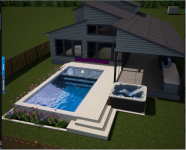Hello TFPers!
I'm looking to install a small, simple rectangular pool in Austin, Texas this year (max 14' x 26'), and I'm evaluating fiberglass versus gunite. Pool will be for adulting/beveraging/beating the heat, ideally with a small tanning ledge. Going rectangular so we can install a hidden cover.
My backyard is sloped away from the house/deck. We want to have the coping of pool approximately level with the back door (accounting for drainage, of course), and ideally the deep end of the pool will be ~16-20" above the flowerbox on the far side of the pool.
I did a fair amount of research/searching, but I cannot find an answer to my question - can a fiberglass pool be installed, trouble free, with the deep end of the pool partially above ground? IE can we build a concrete wall on the far side of the pool (away from the house) that collars/locks the fiberglass shell in place?
If so, would that collar/wall need to be thicker than the 12" coping that the gunite PBs are recommending? The other two sides of the shell will have 4-5' concrete pours up to the foundation of the house and deck.
Attached are photos of the back yard, along with renderings from one of the gunite PBs we are considering. Hot tub is an above ground Hot Springs Grandee that will go on a concrete pad we'll pour as part of the pool build. That pad will be lower than the decking for the pool, so entry to the tub will be easier and safer.
Thanks,
JP
I'm looking to install a small, simple rectangular pool in Austin, Texas this year (max 14' x 26'), and I'm evaluating fiberglass versus gunite. Pool will be for adulting/beveraging/beating the heat, ideally with a small tanning ledge. Going rectangular so we can install a hidden cover.
My backyard is sloped away from the house/deck. We want to have the coping of pool approximately level with the back door (accounting for drainage, of course), and ideally the deep end of the pool will be ~16-20" above the flowerbox on the far side of the pool.
I did a fair amount of research/searching, but I cannot find an answer to my question - can a fiberglass pool be installed, trouble free, with the deep end of the pool partially above ground? IE can we build a concrete wall on the far side of the pool (away from the house) that collars/locks the fiberglass shell in place?
If so, would that collar/wall need to be thicker than the 12" coping that the gunite PBs are recommending? The other two sides of the shell will have 4-5' concrete pours up to the foundation of the house and deck.
Attached are photos of the back yard, along with renderings from one of the gunite PBs we are considering. Hot tub is an above ground Hot Springs Grandee that will go on a concrete pad we'll pour as part of the pool build. That pad will be lower than the decking for the pool, so entry to the tub will be easier and safer.
Thanks,
JP
Attachments
-
 Austin Pool with Bench.png410.2 KB · Views: 15
Austin Pool with Bench.png410.2 KB · Views: 15 -
 pool - location of cover - larger steps.png751.7 KB · Views: 15
pool - location of cover - larger steps.png751.7 KB · Views: 15 -
 pool from backyard night.png681.3 KB · Views: 13
pool from backyard night.png681.3 KB · Views: 13 -
 pool from shed area.png1 MB · Views: 15
pool from shed area.png1 MB · Views: 15 -
 Screenshot 2024-01-13 142317.png876.2 KB · Views: 15
Screenshot 2024-01-13 142317.png876.2 KB · Views: 15 -
 Screenshot 2024-01-13 142354.png444.6 KB · Views: 15
Screenshot 2024-01-13 142354.png444.6 KB · Views: 15 -
 Screenshot 2024-01-13 142418.png458.9 KB · Views: 16
Screenshot 2024-01-13 142418.png458.9 KB · Views: 16


